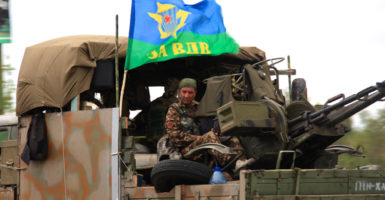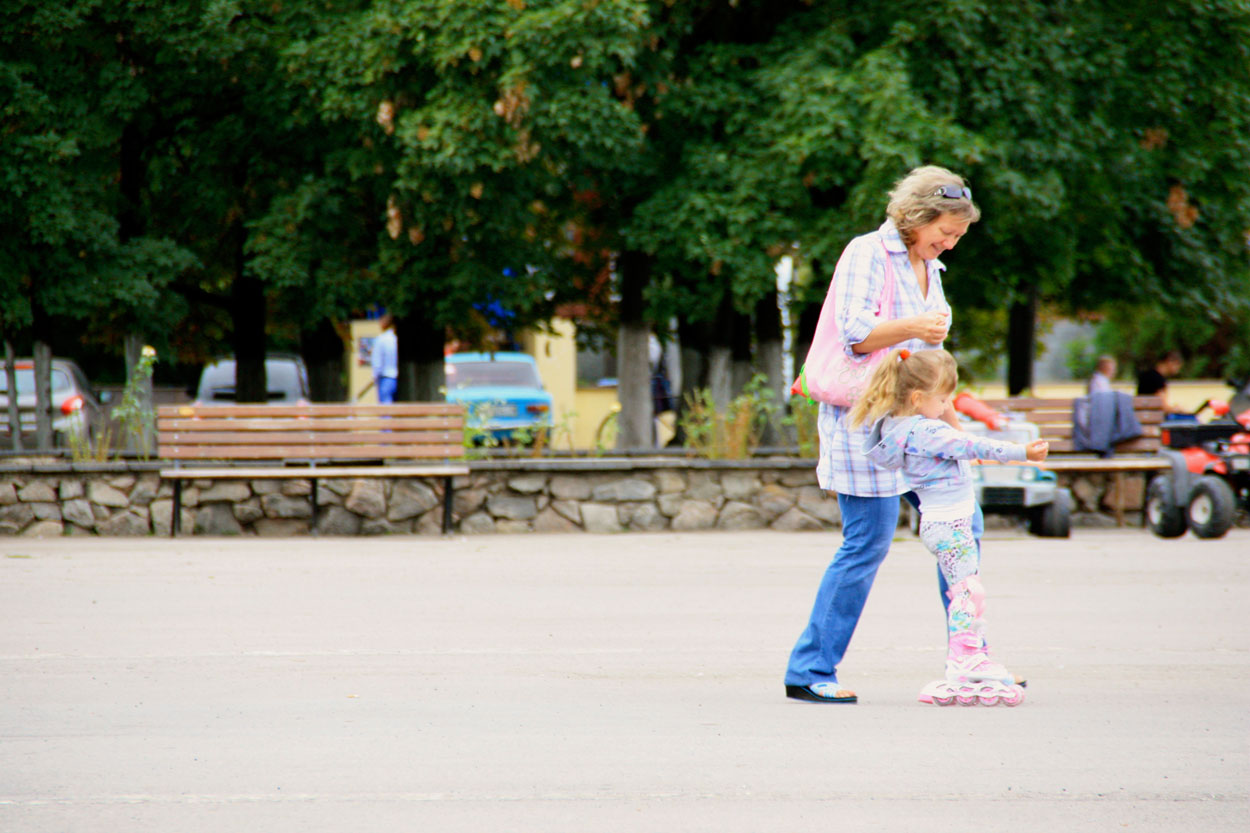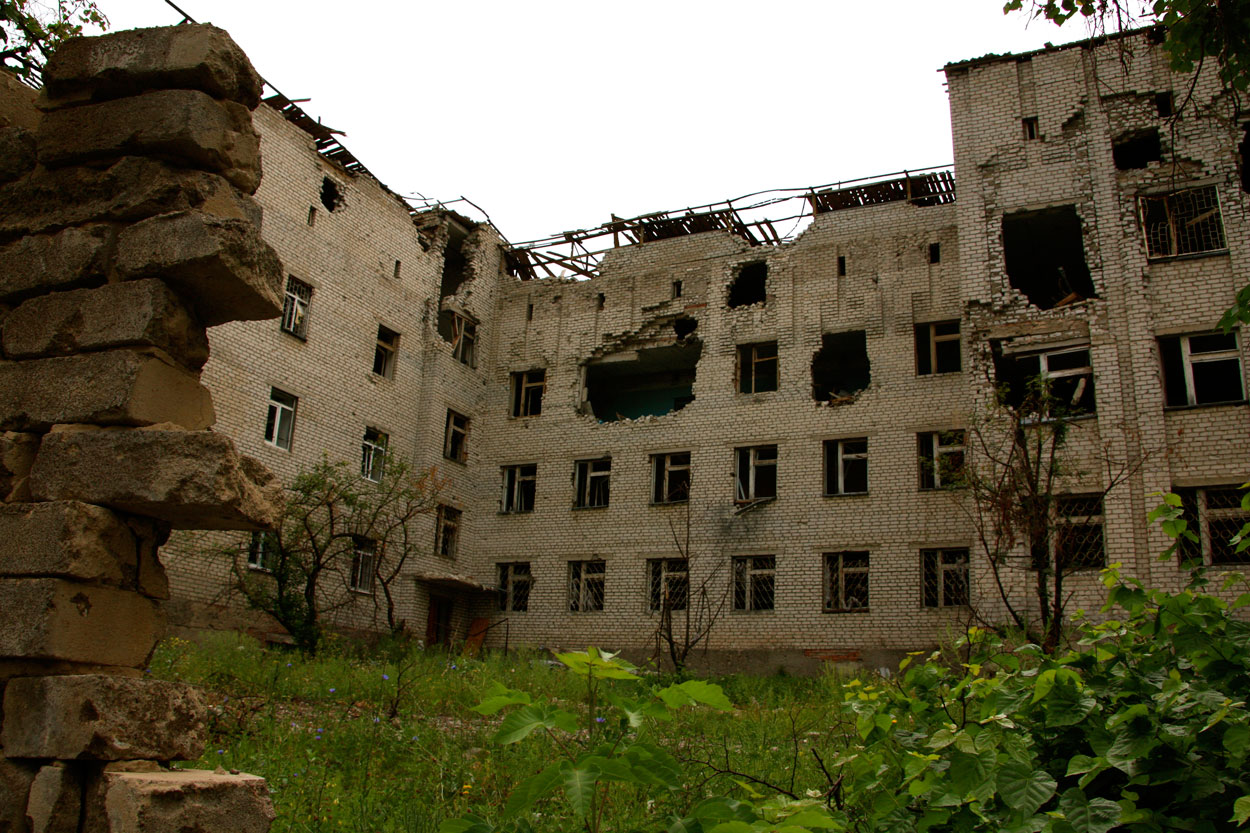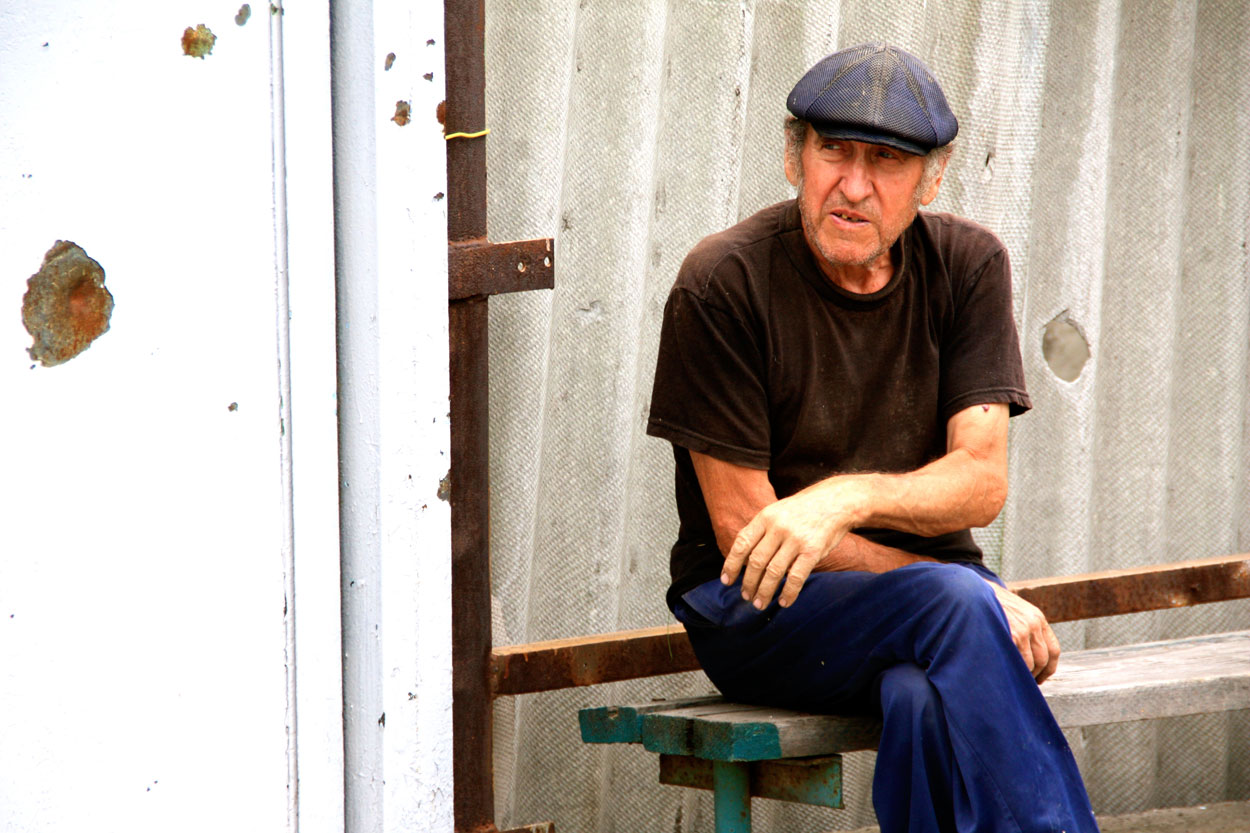KYIV, Ukraine—In 2014, the eastern Ukrainian city of Sloviansk was at the epicenter of the separatist insurgency, which, with financial and military backing from Moscow, spawned two breakaway republics in eastern Ukraine.
That April, combined Russian-separatist forces seized control of Sloviansk. According to accounts from civilians living in the city at the time, Russian special forces troops and agents from Russia’s security services operated openly among the separatists’ ranks.
After more than four years, Russia is still waging a proxy war in eastern Ukraine. More than 10,300 Ukrainians have died. And the deaths, civilian and military, continue to mount.
The war is not a civil war. It remains, and always has been, a Russian invasion.
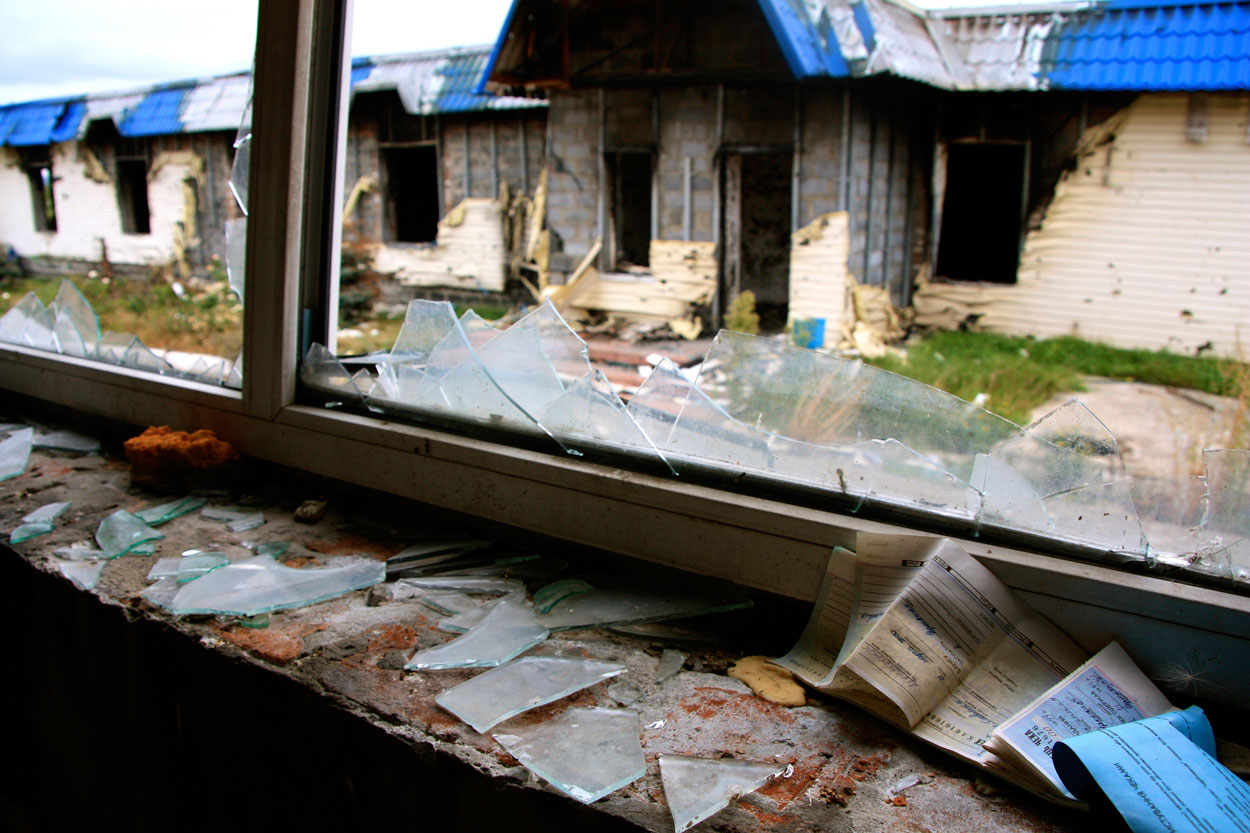
Battle damage in Semyonovka, eastern Ukraine, in August 2014. (Photos: Nolan Peterson/The Daily Signal)
“When the war started, all these men arrived in town, speaking in accents from Moscow, or St. Petersburg,” said Oleksandr Derevyanko, a soldier in the pro-Ukrainian Aidar Battalion, explaining what happened in Sloviansk in the opening weeks of the war in April 2014.
“It was a Russian military operation,” said Derevyanko, who was a soldier in the Soviet Red Army in Afghanistan during the Cold War.
“But Russia says it wasn’t involved,” I replied, playing the devil’s advocate.
Derevyanko narrowed his eyes at me. “Everything Russia says is a lie,” the old soldier said.
A Real War
In July 2014, Ukrainian military units launched an operation to liberate Sloviansk, a city of about 100,000 in Ukraine’s embattled eastern Donbas region. It was a brutal fight.
Artillery and tank shots rained down, and small arms gunfights broke out in the streets. About 40 percent of the city’s population already had fled by the time the war arrived, but for those who remained, it was a terrifying time.
On July 5, 2014, after weeks of heavy fighting, Ukrainian forces retook control of Sloviansk. Overall, about 100 people died in the fighting.
It wasn’t quite a Pyrrhic victory, but the battle to liberate Sloviansk left scars. Most notably in a nearby village called Semyonovka, which the shells, mortars, and rockets practically leveled.
It was only a few weeks after the battle when I first visited in August 2014. Buildings in Sloviansk remained pockmarked by bullet holes and artillery shrapnel (four years later, the city still bears battle scars).
And in Semyonovka, residents who had fled the shelling were trickling back, returning to the debris fields that used to be their homes.
We entered Sloviansk through a road that cut through a tree tunnel. Sergei, our driver, explained how just weeks earlier, Ukrainian troops had to clear the road of tree trunks and branches the separatists had piled up as a barrier against the Ukrainian advance. We passed a factory with massive, ragged holes in its walls. A separatist unit had holed up here, Sergei said, and the Ukrainians had taken care of it with mortars and tank shots.
More ramshackle checkpoints lined the road into town. The Ukrainian military was, at that time, still a ragtag force, using whatever was available from Soviet surplus and the donations of civilian volunteers to mount its war effort. It was well equipped with tanks, weapons, and ammunition—but mostly from the ’70s and ’80s.
A lot of the rifles and ammunition dated as far back as the 1960s and 1950s. Yet, at that time, the separatists were also fighting with Soviet hand-me-downs. That was to change in August 2014, when Russia’s regular army invaded southeastern Ukraine and routed the Ukrainians in a lethal double-cross at the battle for Ilovaisk.
Today, Ukraine’s two separatist breakaway republics, which comprise about 5 percent of Ukraine’s landmass, have a combined tank force bigger than that of Germany, France, and the Czech Republic put together. According to the Kremlin—if that’s where you choose to get your information—that arsenal was amassed without any Russian help.
After more than four years of reporting on the war in Ukraine, I’ve still yet to run across a store selling tanks, or surface-to-air missiles, or Grad rockets in eastern Ukraine.
Yet, the Kremlin maintains that the so-called separatists in eastern Ukraine (a force of disaffected Ukrainian coal miners and farmers, Moscow says) amassed their combined armed forces without Russia’s help.
But I digress.
Upon my first entry to Sloviansk that August of 2014, I met with a detachment of Ukrainian army soldiers. We had a look around town.
At the central square, a statue of Vladimir Lenin still stood. Beneath it, children were on rollerblades, and a man on a bicycle peddled past. Just a block away, apartment buildings bore the scars of machine gun bullets and mortars. A convenience store had half its roof caved in from a mortar.
Just weeks after street-to-street fighting wrecked this town, the normal rhythms of life seemed to be restored. On that day, children were on the sidewalks with their backpacks, probably on their way to school. The buses were running, people were out grocery shopping. One lady with a cigarette in her lips smiled and waved to me from her apartment window a few stories above as I walked down the sidewalk snapping photos.
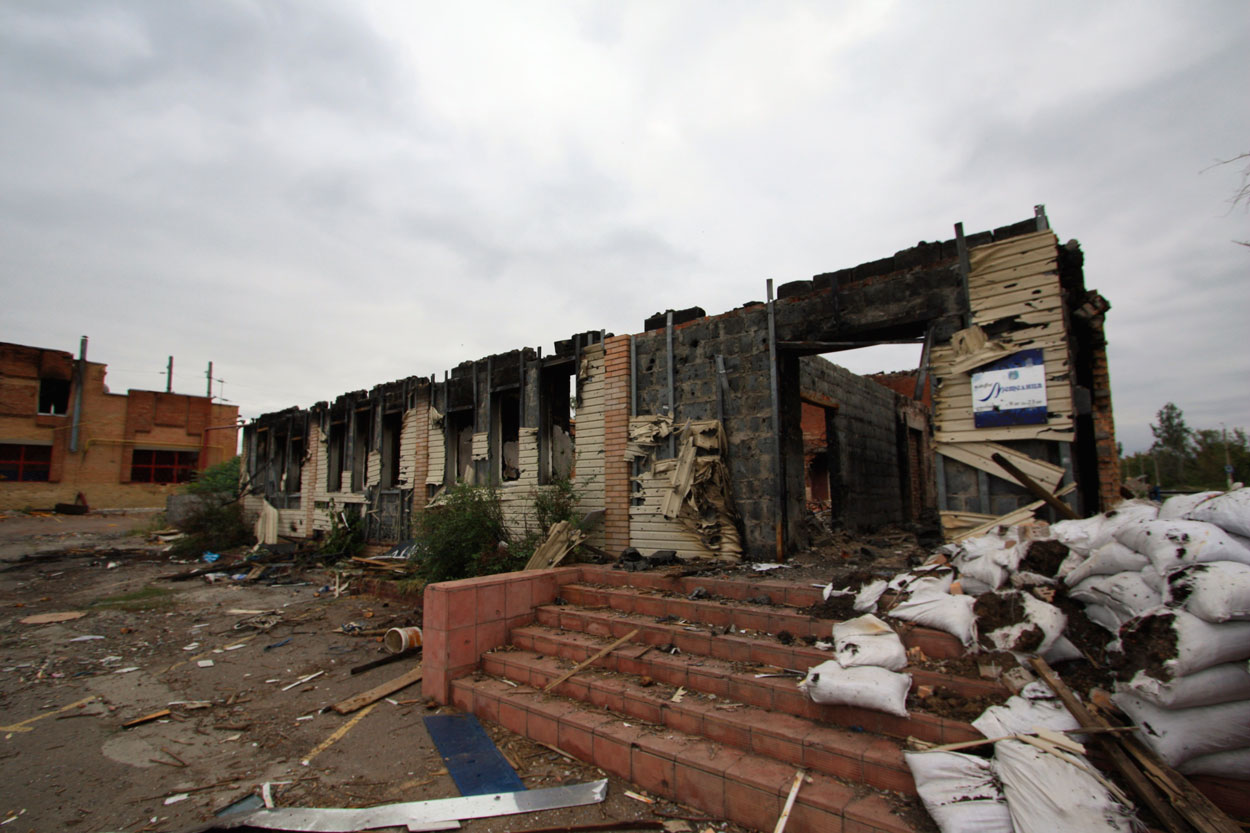
Despite an influx of heavy weapons on the combined Russian-separatist side, Moscow says it’s not involved in the war in Ukraine.
We followed the trail of the fighting through Sloviansk across a bridge on the edge of town to a crossroads in the small village of Semyonovka. This is where the battle had been its fiercest, and the destruction was most severe.
At one corner of the crossroads was a demolished bus depot. At the artillery-razed spot, a woman and her child sat on their suitcases waiting for a ride. Across the intersection was a razed yellow home. It was like a gingerbread house that some ravenous child had dug into.
Gouged, half collapsed, a tattered ruin of what it had been. The trace of machine gun bursts cut up, down, and diagonally across its walls among the burnt impact marks of rocket-propelled grenades. The fins of unexploded mortars stuck out from the earth and pavement. And there were craters, sometimes as deep as I am tall, scooped into the black soil.
There weren’t many people left in Semyonovka. Craters churned the earth into what looked like the choppy surface of a stormy sea. Artillery had stripped trees bare of their branches and left behind charred trunks like telephone poles. Every vertical surface was pockmarked by shrapnel. Almost every home or structure lay in ruins.
It was like the aftermath of a Category 5 hurricane. I remember when my dad drove me through southern Florida after Hurricane Andrew. Sloviansk was like that. The storm of steel had spared nothing.
It looked like a scene out of a World War II movie. Except this was Europe, in 2014. And it’s still going on today.
The sky was gray that day. The air was still and cool and with hardly a car on the road, except for the occasional convoy of Ukrainian troops moving back and forth from the front. I walked the ravaged streets with my fixer, then a lanky and gregarious, 21-year-old named Valentyn Onyshchenko.
From time to time, we peered into the occasional home. Inside we would see the scattered debris of lives interrupted. Scorched teddy bears buried under broken pots and pans. Family photo albums singed at the edges lying amid piles of bullet shell casings. A horseshoe nailed to a shrapnel-shredded white wall.
It was a miracle anyone could have survived this, I remember thinking. I tried my hardest to imagine what it must have been like to be present during the battle. To witness the rage and fury of the artillery that caused such damage. But, at that time, I had no way to imagine such a thing.
Most of Semyonovka’s residents had fled before the fighting, but a few had decided to stick it out. They survived by hiding in their basements as the artillery rained down outside. As I walked around Semyonovka that day with Onyshchenko, I had a chance to speak with some of these residents who had stayed and survived.
We chatted with 63-year-old Alexandra as she waited by the side of the road in one of Semyonovka’s ruined streets for a bus to take her into Sloviansk for groceries. Ukrainian military convoys passed by on the road, transporting troops to the front line. Alexandra stood there with her arms crossed and spoke in a matter-of-fact way about the battle that destroyed every home on her street, including her own.
“It was very bad when the separatists were in charge,” she said. “There was no food. In order to eat, we had to harvest what we could.”
Alexandra initially tried to ride out the fighting by hiding in her basement. But she eventually had to flee when artillery leveled the above-ground portion of her home. Her son came to take her away to a safe place. After the town was liberated, she decided to come back.
“I came back because this is my place,” she told me. “ This is my home.”
Later, we met 72-year-old Anatoli Bastriski. He wore a blue paddy cap and sat on a green bench outside his home with one leg crossed over the other and his arms folded across his thigh. Shrapnel holes pockmarked the wall behind him. The street was mostly cleared of debris, but almost every skeleton of a home along the way was unoccupied. There was no one else on the road.
Bastriski was Jewish. He was an infant when the Nazis occupied this part of Ukraine, he said. Somehow, his entire family had survived the Holocaust.
Seventy years later, rather than flee when the shells began to fall, Bastriski chose to remain in Semyonovka and waited out the battle in his basement. Even when the roof of his brick home was obliterated by the shells, he refused to leave.
“I wasn’t scared,” Bastriski said. “I had potatoes. It was all I needed.”
Behind him, Bastriski’s home had a new aluminum roof. The Ukrainian government paid for it, he said. He deflected questions about whether his allegiance was with the separatists or Ukraine. He seemed to be equally disdainful of both sides. His one true allegiance was to his home.
“I was born here and I built my home with my own hands,” he said. “The Germans destroyed my parents’ home. I’ll rebuild this one.”
I asked Bastriski why he chose to stay in Semyonovka. Why not move somewhere else? The old man cracked a half-smile beneath the paddy cap, shrugged his shoulders, and said, “I’d leave, but the cemetery is too far away.”
‘We Saw It on the News’
Later in Semyonovka, I encountered evidence of the war’s most lethal weapon, more powerful than any bullet or bomb. Onyshchenko and I approached one family: a man, his wife, and a teenage son. They were clearing away rubble from the collapsed wall of their home.
The man and his son were dismantling a crumbled brick wall while the wife carted the rubble away in a wheelbarrow. An enormous crater was in the road just opposite the entrance to the house. The solid metal gate to their courtyard looked like a Jackson Pollock painting.
The shrapnel holes, which had punched straight through the half-inch, aqua blue-painted metal, were arranged in amorphous shapes like they had dripped or flung from a brush onto the sheet metal canvas. Rust had begun to ring the sides of the punctures, and it was all multicolored, abstract, and, truly, quite beautiful—if you don’t consider its genesis, of course.
The family had been there for the battle, the man said. They had experienced it firsthand, sheltering in their cellar to keep safe. I asked, through Onyshchenko’s translations, who was responsible for the damage. Which side fired the artillery that had destroyed their home and their village?
I waited for a response incriminating either the Russians and their separatist proxies, or the Ukrainian army. Instead, the reply I got was something wholly unexpected.
“The American CIA bomber planes did this,” the man confidently said.
“This is all America’s fault,” the woman interjected as she loaded more rubble into her wheelbarrow. “The stupid people in the White House are causing problems all over the world.”
Now, admittedly, as a former Air Force pilot, I was more than a little skeptical that America—and our CIA bomber planes, no less—were out carpet-bombing the Donbas. I pressed the man for more information. And, for the record, I pretended I was a French journalist. I could tell my American credentials were not going to get me far in this instance.
“Why do you believe it was the, um, American CIA bomber planes which did this?” I asked through Onyshchenko’s translations. “Could you see them?”
“No, but we could hear them,” the man replied.
“And you know they were American?”
“Yes,” the man answered. “We saw it on the news.”
And there it was.
I later learned that this area had been receiving only Russian TV news broadcasts for a few months. The local tower transmitting Ukrainian broadcast channels was one of the first things the combined Russian-separatist forces had destroyed when they took over the area. A decapitation strike, as we say in the U.S. military.
Except the Russians weren’t going after Ukrainian leadership. They were going after something more important—total mind control of the hapless civilians living in this gray zone.
Under the glamour of Russian propaganda, this family before me, these eyewitnesses to a battle—who seemed at first impression like average, reasonable people—were willing to distrust their own senses and their own memories to believe something a Russian newscaster reporting from behind a desk hundreds of miles away had told them was true.
Granted, I’m totally aware of the fog of war and how memories of stressful situations are often remarkably unreliable. Still, that family had to suspect what they had heard from Russian news was a lie.
But they said that their village, this isolated hamlet in the fields of eastern Ukraine, had been the target for a fleet of “American CIA bomber planes.” They thought so because that’s what the Kremlin wanted them to believe.

In August 2014, the statue of Vladimir Lenin still stood in central Sloviansk. It has since come down.
Then, in that moment, as I looked into the eyes of that family, I saw not a flicker of skepticism in the things they told me. This was my education in a new kind of war, Russia’s “hybrid war.” A way of conflict in which propaganda was just as lethal as any kinetic weapon.
Or, maybe, that made this war just like any other. I bet Athenian scribes worked hard to shape public opinion among their enemies, too. So let’s be honest, Russian President Vladimir Putin didn’t invent propaganda—he’s just wielded it particularly well.
And I can attest to its potency.
The First Casualty
On that first trip to the Ukrainian war zone in the summer of 2014, I finally, truly understood what my friend James Foley had died for.
An American journalist covering the Syrian civil war, Foley was kidnapped and murdered by Islamic State militants in August of 2014, around the same time I first ventured to the front lines in eastern Ukraine.
Fresh off a career as an Air Force special operations pilot, I still had a lot to learn about conflict journalism four years ago. (Probably still do, too.)

A woman clears away rubble in Semyonovka in August 2014 after combat between Ukrainian forces and Russia’s separatist proxies left most of the village in ruins.
But I already had learned my most important lesson about this war, or any other.
We can’t let the first draft of history be written by Kremlin propagandists or ISIS snuff videos.
I wasn’t a soldier anymore, but I understood I was on the front lines of another kind of war out there in eastern Ukraine—and I was defending something more precious than territory.
Only days after I had learned of Foley’s murder at the hands of ISIS, it was a chilling reminder that, as a journalist, I was not just a skipping stone, touching down lightly and shallowly in the war. I was neck deep in it, because I wielded one of the most lethal weapons of all—the truth.
And truth, as they say, is often the first casualty of war.



























